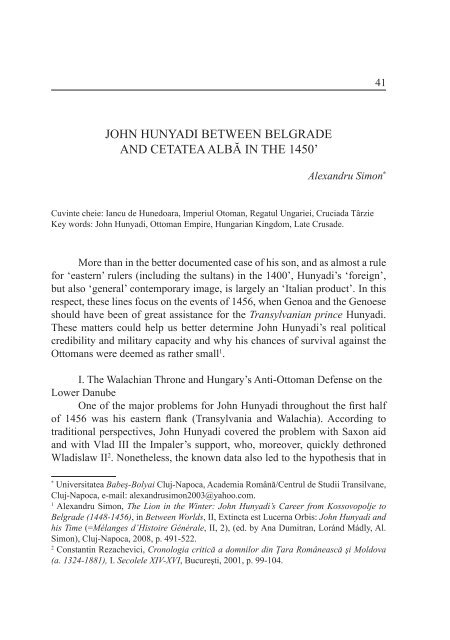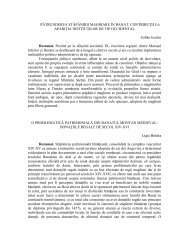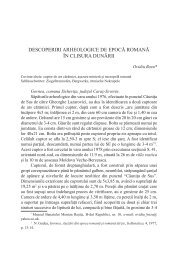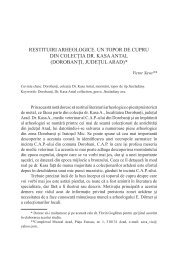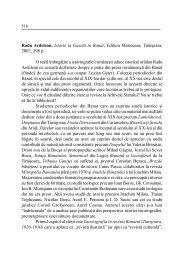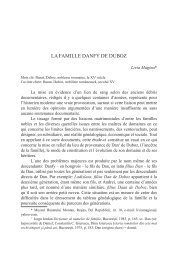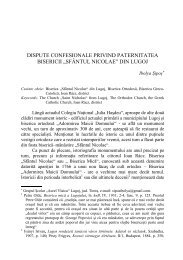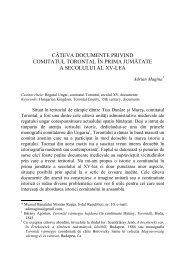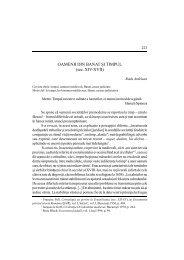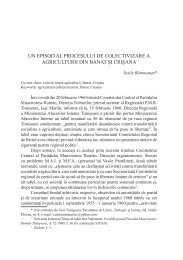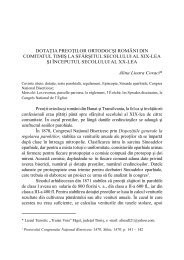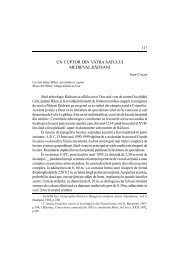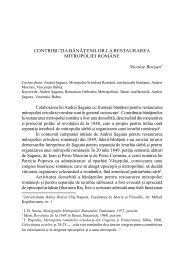jOHN HUNYADI BETwEEN BELGRADE AND CETATEA ... - Banatica
jOHN HUNYADI BETwEEN BELGRADE AND CETATEA ... - Banatica
jOHN HUNYADI BETwEEN BELGRADE AND CETATEA ... - Banatica
You also want an ePaper? Increase the reach of your titles
YUMPU automatically turns print PDFs into web optimized ePapers that Google loves.
<strong>jOHN</strong> <strong>HUNYADI</strong> <strong>BETwEEN</strong> <strong>BELGRADE</strong><br />
<strong>AND</strong> <strong>CETATEA</strong> ALBă IN THE 1450’<br />
41<br />
Alexandru Simon *<br />
Cuvinte cheie: Iancu de Hunedoara, Imperiul Otoman, Regatul Ungariei, Cruciada Târzie<br />
key words: john Hunyadi, Ottoman Empire, Hungarian kingdom, Late Crusade.<br />
More than in the better documented case of his son, and as almost a rule<br />
for ‘eastern’ rulers (including the sultans) in the 1400’, Hunyadi’s ‘foreign’,<br />
but also ‘general’ contemporary image, is largely an ‘Italian product’. In this<br />
respect, these lines focus on the events of 1456, when Genoa and the Genoese<br />
should have been of great assistance for the Transylvanian prince Hunyadi.<br />
These matters could help us better determine john Hunyadi’s real political<br />
credibility and military capacity and why his chances of survival against the<br />
Ottomans were deemed as rather small 1 .<br />
I. The walachian Throne and Hungary’s Anti-Ottoman Defense on the<br />
Lower Danube<br />
One of the major problems for john Hunyadi throughout the first half<br />
of 1456 was his eastern flank (Transylvania and walachia). According to<br />
traditional perspectives, john Hunyadi covered the problem with Saxon aid<br />
and with Vlad III the Impaler’s support, who, moreover, quickly dethroned<br />
wladislaw II 2 . Nonetheless, the known data also led to the hypothesis that in<br />
* Universitatea Babeş-Bolyai Cluj-Napoca, Academia Română/Centrul de Studii Transilvane,<br />
Cluj-Napoca, e-mail: alexandrusimon2003@yahoo.com.<br />
1 Alexandru Simon, The Lion in the Winter: John Hunyadi’s Career from Kossovopolje to<br />
Belgrade (1448-1456), in Between Worlds, II, Extincta est Lucerna Orbis: John Hunyadi and<br />
his Time (=Mélanges d’Histoire Générale, II, 2), (ed. by Ana Dumitran, Loránd Mádly, Al.<br />
Simon), Cluj-Napoca, 2008, p. 491-522.<br />
2 Constantin Rezachevici, Cronologia critică a domnilor din Ţara Românească şi Moldova<br />
(a. 1324-1881), I. Secolele XIV-XVI, Bucureşti, 2001, p. 99-104.
42<br />
fact Vlad (III) acted ‘on behalf’ of sultan Mehmed II (view pre-dominant in<br />
Romanian historiography in the late 1800’ 3 ).<br />
1. The Hunyadis and the walachian Loyalty of the House of Dracul in<br />
the Mid 1450’<br />
Critobulos, Chalcondylas, Tursun Bey, or kemal Pasha Zade, all<br />
claim that that Vlad III took the throne with Ottoman support 4 . This however<br />
may have applied only for his first short reign in 1448. Yet, none of these<br />
Late Byzantine and Ottoman chronicles, which devote much space to the<br />
walachian-Ottoman war of 1461-1462, even implied that Vlad III had been<br />
hostile to the Porte prior to those years, which would have been the case if he<br />
had been enthroned by Hunyadi in 1456 5 .<br />
Basarab IV Ţepelus (the Little Impaler), wladislaw II’s cousin accused<br />
the Saxons of Braşov (in late 1479) of sheltering a pro-Ottoman boyar faction<br />
which had caused much damage to Christendom, and had helped enthrone<br />
Vlad III and kill wladislaw II 6 (in 1475, Basarab IV had been the walachian<br />
candidate of both the Saxons and Stephen III of Moldavia, who did not want<br />
Vlad III the Imapler back on the throne). Only weeks prior to this letter, Basarab<br />
IV had assisted the Ottomans on their unsuccessful Transylvanian campaign.<br />
In return, the repertory of charges brought against this faction, covering more<br />
than two decades, brought forth by him, perfectly suits walachian politics.<br />
Vlad III of walachia in Buda and Transylvania after 1451<br />
Regardless of interpretation, a credible analysis must begin in john<br />
Hunyadi’s time. According namely to the various German drafts of the later<br />
3 In particular Constantin A. Stoide, A doua domnie a lui Vlad Ţepeş. Luptele pentru<br />
ocuparea tronului şi consolidarea domniei (1456-1458), in AIIA Iaşi, XXII, 1986, 1, p. 111-<br />
130.<br />
4 Laonic Chalcocondil, Expuneri istorice. Historiarum demonstrationes (ed. by Vasile Grecu),<br />
Bucureşti, 1958, p. 283; Cristobul din Imbros, Din domnia lui Mahomed al II-lea (1451-1467<br />
(ed. by V. Grecu ), Bucureşti, 1963, p. 290; Tursun Bey and Kemal Pasha Zade, in Cronici<br />
turceşti privind ţările române. Extrase, I, Secolul XV-mijlocul secolului XVII (ed. by Mihail<br />
Guboglu, Mustafa Mehmet), Bucureşti, 1966, p. 67, 198.<br />
5 The same applies for western sources Al. Simon, Dracula in Hungary: Crusades, Estates<br />
and Brides (1462-1476), in Annuario, X, 2008, forthcoming.<br />
6 Ioan Bogdan, Documente privitoare la relaţiile Ţării Româneşti cu Braşovul şi Ungaria în<br />
secolele XV şi XVI , Bucureşti, 1905, no. 121, p. 149-151 (henceforth: Documente Braşov).
stories on Dracula, he enthroned Vlad III in 1456, in exchange for numerous<br />
promises 7 . Earlier, in April 1456, relations between wladislaw II and john<br />
Hunyadi had been hostile again, though both were disposed to accept king<br />
Ladislas V’ arbitrage. The king was willing to mediate the conflict for we want<br />
to make justice and right to wladislaw II. Until then, he instructed the Saxons<br />
to defend Hunyadi’s lands in case wladislaw would attack 8 .<br />
On july 3, 1456, from Cuvin (keve), john Hunyadi informed the jurors<br />
of the Seven Saxon Seats that he had entrusted their defence to voivode<br />
Vlad 9 . Vlad III had first been a ruler of walachia in 1448 (a voivode’s son or<br />
brother, without having ruled until then, could also be called voivode 10 ). Then<br />
wladislaw II had joined Hunyadi on his Serbian campaign, which allowed the<br />
Ottomans to enthrone Vlad III. In spite of the defeat of kossovopolje, Vlad<br />
still soon lost his throne 11 .<br />
The only known direct documentary evidence on Vlad (the future<br />
Impaler) afterwards comes from February 1452, Following the Ottoman-<br />
Hungarian ‘peace’ of November 1451, confirmed in April 1452 (which<br />
guaranteed wladislaw II’ walachian rule), john Hunyadi ordered that Vlad<br />
III should be expelled to Moldavia, where he had come from, probably<br />
only months earlier 12 . It is nonetheless uncertain whether Vlad III, as other<br />
contenders, was actually expelled from Transylvania.<br />
Bonfini 13 stated that Wlada Montanae Valachiae princeps attended the<br />
talks of Buda on the anti-Ottoman defense of the realm (summer 1455), while<br />
Thuróczy 14 , wrote that john Hunyadi brought back Vlad III and introduced him<br />
at court, seemingly at the time of the formal reconciliation between Hunyadi<br />
7 The main examples can be found in Matei Cazacu, Dracula [suivi du “Capitaine Vampire”<br />
une nouvelle roumaine par Marie Nizet (1879)], Paris, 2004, p. 369, 439.<br />
8 DRH, D, Relaţiile între Ţările Române, I, 1222-1456, (ed. Ştefan Pascu, Constantin Cihodaru,<br />
konrad G. Gündisch, Damaschin Mioc, Viorica Pervain), Bucureşti, 1977, no. 330, p. 450.<br />
9 DRH, D, I, no. 333, p. 455.<br />
10 Dan, wladislaw II’s brother and contender to Vlad’s throne, DRH, D, I, no. 341, p. 461.<br />
11 M. Cazacu, La Valachie et la bataille de Kossovo, in RESEE, IX , 1971, 1, p. 131-139.<br />
12 DRH, D, I, no. 308, p. 423.<br />
13 [Antonio Bonfini] Antonius de Bonfinis, Rerum Ungaricarum decades, (ed. józsef Fógel,<br />
László juhász, Béla Iványi), III, Leipzig, 1939, p. 37.<br />
14 [jános Thuróczi/ Thuróczy] johannes de Thurocz, Chronica Hungarorum, I, Textus, (ed.<br />
Erzsebet Galántai, Gyula kristó) Budapest, 1985, p. 245.<br />
43
44<br />
and Ulrich von Cilly (early 1453). Gustav Gündisch 15 redated Vlad’s meeting<br />
with Ladislas to March 1456. This can be accepted, as well as rejected. In<br />
1453, prior to the fall of Byzantium, john’s relations to wladislaw were good,<br />
but, by bringing Vlad to Buda, Hunyadi may have, successfully attempted (for<br />
the moment) to put pressure on wladislaw II, a common political move.<br />
The bad blood between john Hunyadi and the Drăculeşti (in 1447 john<br />
Hunyadi had Vlad II executed), was seemingly left aside for the moment.<br />
But, immediately after the tide turned against john Hunyadi’s first born son,<br />
Ladislas, two days before the latter’s execution on the 16 th of March, 1457,<br />
Vlad III the Impaler reminded the Saxons of how john Hunyadi’s trustees<br />
john Geréb of Vingárt and Nicholas Vizaknai (of Ocna Sibiu/ Salzburg) the<br />
Elder had attempted to kill him, out of love for wladislaw II of walachia 16 .<br />
The safest dating for this event remains the year 1452.<br />
The Sons of Vlad II Dracul and john Hunyadi<br />
By early September, when Vlad wrote to Braşov as ruler of walachia,<br />
wladislaw II (his last known docu-ment dates back to April 1456) had lost<br />
his throne 17 . According to his tombstone in the Dealu monastery from the<br />
1510’, he died on August 20, 6983 [1455]. The year is certainly mistaken.<br />
Still, the day and month of his death cannot be automatically regarded as also<br />
mistaken 18 .<br />
If we accept them, a scenario would be that, after sultan Mehmed II the<br />
Conqueror retreated from Belgrade in late july 1456, Vlad III the Impaler took<br />
his Transylvanian troops and made his move against the acting ruler wladislaw<br />
II. The latter was eventually defeated and lost his life. Previously, due to<br />
Mehmed II’s orders, or out of fear of Vlad III, wladislaw II had not left for<br />
Belgrade. No known source records the walachians as Ottoman ‘auxiliaries’<br />
there. In general, even at the risk of temporarily losing control over walachia,<br />
the sultan took with him the ruler or at least the main core of his army, like in<br />
15 Cu privire la relaţiile lui Vlad Ţepeş cu Transilvania în anii 1456-1458, in Studii, XVI<br />
(1963), 4, p. 682-683.<br />
16 Documente Braşov, no. 259, p. 319.<br />
17 DRH, D, I, no. 339, p. 456.<br />
18 Alexandru Lapedatu, Mormintele domneşti de la mănăstirea Dealul, in CLit., XXXVII<br />
(1903), p. 433-434.
the case of the Moldavian campaigns of 1476 and of 1484 19 .<br />
Vlad III the Impalers’s first two letters to Braşov (September 6 and 10,<br />
1456) are a collection of twists and turns in phrasing and a mixture of direct<br />
statements and indirect reference. They sound strange for somebody who<br />
‘had’ late john Hunyadi’s and king Ladislas V’ full approval for his rule 20 .<br />
Though he feared the Turk, and wanted to work for the defense of his land<br />
and of the realm, not directly against the Turk, but only to soften his stand<br />
towards walachia and weaken her burden, Vlad III was already the Porte’s<br />
vassal. Though, given his meeting with Ladislas V, the task entrusted to ‘him’<br />
by Hunyadi and his walachian victory, Vlad had normally proven his loyalty,<br />
he still wanted (had) to prove and do his loyalty. No mention was made of the<br />
late Hunyadi 21 .<br />
After Ladislas Hunyadi’s coup of Belgrade (November 1456), Vlad<br />
III the Impaler’s relations to the Hunyadis became officially hostile. By<br />
mid December, the royal decision had been taken to replace Vlad III with<br />
Dan voivode. Ladislas Hunyadi instructed the Saxons to support Dan 22 .<br />
He mentioned the broken promises made by Vlad III the Impaler while<br />
extra regnum suum esset, but not his father’s direct involvement in Vlad’s<br />
enthronement. In mid March 1457, while accusing john Hunyadi’s men of<br />
attempted murder, Vlad stated that he owed his throne only to God 23 . At any<br />
rate, asides from the impact of john Hunyadi’s death, ties between Vlad III the<br />
Impaler and john Hunyadi’s party, as well as to the king, were probably not<br />
that strong when Vlad III won the throne.<br />
2. The walachian Front between Belgrade and Chilia in the Spring and<br />
Summer of 1456<br />
In March 1456, according to the Ragusans, the Ottomans were<br />
already attacking the remainders of Serbia and were also preparing to<br />
19 See also Al. Simon, The Limits of the Moldavian Crusade (1474, 1484), in Annuario, IX ,<br />
2007, p. 244-248.<br />
20 DRH, D, I, nos. 338-339, p. 456-460,<br />
21 In these matters, see also Al. Simon, În jurul bătăliei de la Vaslui (1474-1475). Consideraţii<br />
asupra relaţiilor dintre Regatul Ungariei, Moldova şi Ţara Românească, in SUBB.Historia,<br />
XLIX, 2004, 2, p. 9-10, 19-20.<br />
22 DRH, D, I, no. 341, p. 461.<br />
23 Documente Braşov, no. 259, p. 319.<br />
45
46<br />
occupy walachia 24 . In April, preparations and clashes along the Danube line<br />
intensified. In exchange for his support of the cross, despot Branković was<br />
‘freed’ by Hunyadi. Rumors arose that many barons taken together with john<br />
Hunyadi the cross 25 .<br />
In late May, clashes intensified, proving Ottoman superiority and<br />
bringing George Branković close to catastrophe. One report that reached the<br />
Italian Peninsula spoke of disaster and fear 26 :<br />
[...] El Turcho era venuto verso le parte de Valachia e del/ despoto<br />
de Rassia cum grande zente. El quale despoto credio havesse cum<br />
desordine/ cum alchune zente circha persone VIIII m ando per assaltarli,<br />
ma trovo li Turchi bene/ in ordine et hebe la pegore. Ne rimaso prexi<br />
et morti la piu parte d’essi VIIII m ./ Poy el prefato Turcho sente ch’el<br />
Papa, la Maesta del Re d’Aragona et ducha de Burgogna andavano/<br />
overo mandavano alchuna possanza verso Constantinopoli, delibero<br />
de ritornare indireto/ per provedere a dicta citta de Constantinopoli. Et<br />
cossi ritorno cum una parte de sua/ zente piu utille. Li altri sono restati<br />
ad damni del prefato despoto e de Valachi./ El Brancho [Hunyadi] sta<br />
la vicino ad guarda del Danubio; aspetta grande exercito de/ Ungari,<br />
quali non porano metersi insieme fine non sia facto el recolto [...] (18 th<br />
of june 1456).<br />
The walachians too had fought the Ottomans (probably in Oltenia)<br />
and faced defeat. Due to the dates of this report and of Hunyadi’s letter from<br />
Cuvin, their leader was wladislaw II and not Vlad III.<br />
Serbians, walachians and Saxons on the Eve of the Battle of Belgrade<br />
Due to the Ottoman peril of spring, wladislaw II of walachia like Serbian<br />
despot George Branković, had come to an arrangement with john Hunyadi,<br />
24 See józsef Gelich, Lajos Thallóczy, Diplomatarium relationum reipublicae ragusane cum<br />
regno Hungariae. Raguza és Magyarország összeköttetéseinek oklevéltára, Budapest, 1887,<br />
no. 340, p. 589 (henceforth: Raguza).<br />
25 Codex Diplomaticus Partium Regno Hungariae Adnexarum. Magyarország Mellék<br />
tartományainak Oklevéltára (=Monumenta Hungariae Historica, I, 31, 33, 36, 40), II, A<br />
Magyarország és Szerbia közti összeköttetések oklevéltára. 1198-1526, (ed. L. Thallóczy,<br />
Antal Aldásy ), Budapest, 1907, no. 265, p. 199 (henceforth CDH, II, Szerbia).<br />
26 Archivio di Stato di Milano (ASM), Archivio Ducale Sforzesco (A.D.S)., Potenze estere,<br />
Venezia, cart. 343, 1456, fasc. 6, Giugno, nn (18 th of june 1456; a copy from cart. 650,<br />
Ungheria, fasc. 1, nn, was edited, with a mistakes, in CDH, II, Szerbia, no. 269, p. 203).
who needed their support, as much as they needed his. Fearing reconciliation<br />
between Hunyadi and wladislaw, the Porte did not rely anymore (it had been<br />
difficult in the first place 27 ) on wladislaw and planned to settle matters in<br />
walachia 28 .<br />
Immediately after john Hunyadi’s intervention in walachia and the<br />
peace with wladislaw II (October 1455), the Ottomans had entered walachia<br />
(November) and attacked Saam in southern Hungary 29 . They were aided<br />
by several walachians. Also informed by Ragusa (who did not mention<br />
wladislaw II’s involvement), Hunyadi placed responsablity for these events<br />
on wladislaw II in his letter to Braşov (late December), but still asked the city<br />
to inquiry on what had actually happened. wladislaw II’s responsibility was<br />
probably minimal (otherwise, in April 1456, the royal position towards him<br />
would have been different), but Hunyadi’s attitude led to renewed tensions 30 .<br />
In spite of his efforts, wladislaw II of walachia was no match for<br />
the Ottoman military power. After the clashes of May 1456, despot George<br />
Branković was forced into retreat, into a form of benevolent neutrality towards<br />
the crusaders, due to his losses 31 , silence set in on the walachian-Ottoman front<br />
for the entire duration of the battle. Hunyadi had to refocus on Transylvania’s<br />
defense.<br />
john Hunyadi chose Vlad voivode for it. The latter was no ruler of<br />
walachia (otherwise, he would have been named as such). Vlad’s task<br />
(entrusted to him prior to july 3) was to defend southern Transylvania, not<br />
walachia. This had not been task previously, although john Hunyadi’s words<br />
(ecce enim commissimus Vlad wayuode, ut pro defensione vestra semper<br />
inviliget et intendat) could indicate that Vlad was already in Transylvania. If<br />
he had been with john Hunyadi until then, john Hunyadi would have probably<br />
mentioned that he was dispatching Vlad to the defense of the Saxons, which,<br />
now that Vlad’s men defended them, had to quickly send troops to Belgrade 32 .<br />
27 See also Dumitru Năstase, Domnul Ţării Româneşti Vladislav II şi asediul din 1453 al<br />
Constantinopolului, in RI, X 1998, 1-2, p. 85-98.<br />
28 Raguza, nos. 334-337, p. 528-586; no. 340, p. 589, no. 342, p. 592 (September 1455-April<br />
1456).<br />
29 Raguza, nos. 334-337, p. 528-586; DRH, D, I, nos. 328-329, p. 447-449.<br />
30 DRH, D, I, no. 330, p. 450.<br />
31 CDH, II, Szerbia, nos. 270-271, p. 203-204; no. 272, p. 204-206; nos. 729-733, p. 463-471.<br />
32 DRH, D, I, no. 330, p. 450.<br />
47
48<br />
Anti-Ottoman Defense and the Last Two walachian Rulers in john<br />
Hunyadi’s Lifetime<br />
Based on the sources at hand, it is impossible to determine whether<br />
Vlad voivode was Vlad III or his step-brother, the future Vlad IV Călugărul<br />
(the Monk). Likewise, it is difficult to determine if the Saxons actually sent<br />
troops to john Hunyadi (their Ottoman deals suggest the opposite). It is equally<br />
difficult to determine whether wladislaw II of walachia had stopped resisting<br />
the Ottomans prior to july 3. Regardless of options, given the fact that Vlad<br />
III the Impaler dethroned a ruler who fought the Turk, the main problem is the<br />
date of wladislaw II’s death: August 20 or late june/ july 33 .<br />
If wladislaw II of walachia had lost his throne soon after his last known<br />
charter of April, Vlad III would have been the one fighting the Ottomans in<br />
May. This should have left several marks on his and the High Porte’s politics,<br />
which it did not. It is rather unlikely that the fighting between Vlad III (House<br />
of Dracul) and wladislaw II (House of Dan) went on for months. In such<br />
a case, given the traditional fiefs of the Houses (Oltenia for the Dăneşti,<br />
Muntenia for the Dăneşti 34 ), wladislaw II would have retreated to Oltenia,<br />
but he was beheaded in Târgşor in Muntenia, in western walachia, near the<br />
Transylvanian border 35 . Given the fights of May and the subsequent ‘walachian<br />
silence’ during the siege of Belgrade (late july), we date the end of his rule to<br />
late june/ early july.<br />
As for the date of his death, we cannot rule out the possibility of his<br />
survival after August 1456 36 . Neither Vlad III the Impaler, in March 1457, nor<br />
Michael Szilágyi, at that time governor (regent) of Hungary, in March 1458,<br />
in their references to wladislaw II, mentioned him as deceased (condam). It is<br />
thus not impossible that, in case he was still alive, wladislaw II attempted to<br />
retake the throne during the walachian rebellion against Vlad III in the second<br />
33 For these perspectives, see namely I. Bogdan, Vlad Ţepeş şi naraţiunile germane şi ruseşti<br />
asupra lui, Bucureşti 1905, p. 12; Ilie Minea, Din trecutul stăpânirii româneşti asupra<br />
Ardealului. Pierderea Amlaşului şi Făgăraşului , Bucureşti, 1914, p. 47.<br />
34 A. D. Xenopol, Lupta dintre Drăculeşti şi Dăneşti, in AARMSI, 2, series, XXX, 1907, p.<br />
183-272.<br />
35 Istoria Ţării Româneşti 1290-1690. Letopiseţul Cantacuzinesc, (ed. Constantin Grecescu,<br />
Dan Simionescu), Bucureşti, 1960, p. 4.<br />
36 Urkundenbuch zur Geschichte der Deutschen in Siebenbürgen, VI, 1458-1473, (ed.<br />
Gustav Gündisch, Hertha Gündisch, Gernot Nussbächer), Bucureşti, 1981; no. 3116, p. 10;<br />
Documente Braşov, no. 259, p. 319.
half of 1458. The rebellion failed and he was beheaded on August 20, 1458 37 .<br />
The hypothesis should be viewed with caution for it contradicts Basarab IV’s<br />
letter of 1479 and it does not provide a solid answer as to why king Ladislas V<br />
and Ladislas Hunyadi used Dan (not wladislaw) against Vlad in late 1456 38 .<br />
At any rate, it remains quite difficult to determine the identity of<br />
Vlad voivode from john Hunyadi’s message to the Saxons from Cuvin and<br />
subsequently if Vlad III directly came with Ottoman support or if he only<br />
broke his oath to john Hunyadi, attacked wladislaw II from behind and aided<br />
Mehmed II. It is still safer to presume that Vlad voivode was Vlad III and that<br />
he acted from behind against the anti-Ottoman line as soon as john Hunyadi<br />
entrusted the ‘defense of the Transylvanian Saxons’ to him. In 1462, he married<br />
the first of his two wives, closely related to the late Hunyadi 39 .<br />
II. Political Challenges and Options on the Moldavian and Genoese<br />
Shores of the Black Sea<br />
During the events of 1457 and 1458 too, prior and after Ladislas<br />
Hunyadi’s death, the Hunyadi party could not rely on any support from<br />
walachia or from Moldavia, though in theory, both countries (since Stephen<br />
III took the Moldavian throne in April 1457) were ruled by men who had<br />
‘promised’ (and sworn) much to john Hunyadi. Earlier walalachian responses<br />
to john Hunyadi had often been negative. In Moldavia, which until 1448,<br />
held both major gateways to the Black Sea (Chilia and Cetatea Albă), he<br />
was seemingly even less popular 40 . The rulers tried as much a possible to<br />
avoid close ties to him. The magnate and actual ruler of Podolia, Di(e)dri(c)h<br />
Buczacki had a greater influence over Suceava than john Hunyadi 41 . In fact,<br />
Bogdan II, after initial hesitations, was the most loyal to Hunyadi of all these<br />
late medieval rulers. Bogdan II’s rule was both unstable and short.<br />
37 C.A. Stoide, op.cit, p. 128.<br />
38 Documente Braşov, no. 121, p. 149; DRH, D, I, no. 341, p. 461.<br />
39 Al. Simon, The Limits of the Moldavian Crusade..., p. 238.<br />
40 Idem, Porturile Moldovei. Ştefan II, Iancu de Hunedoara şi Murad II în documente italice<br />
(1444-1446) in ASUI, LII-LIII, 2006-2007, p. 7-25.<br />
41 See Sorin Iftimi, La politique de Jean Hunyadi en Moldavie, in Between Worlds, II, p.<br />
369-380.<br />
49
50<br />
1. john Hunyadi’s Danubian and Pontic Interests and the Moldavian<br />
Question after 1448<br />
In August 1451, king Casimir IV of Poland requested 50.000 Turkish<br />
aspers a year (asides probably Moldavia’s normal Polish census) for the<br />
recognition of Bogdan II’s perhaps (potentially) life-long rule 42 . The sum stood<br />
for some 1.500 ducats, 75% of the tribute the Moldavian ruler (by then back in<br />
control over Cetatea Albă) had to pay to the sultan after 1455 43 . The Ottoman<br />
impact on Poland and Moldavia was in fact great prior to 1453. Both in 1450<br />
and in 1451, Polish financial demands from Bogdan II had been calculated in<br />
aspers 44 . A incident can therefore be of interest.<br />
The value of the goods lost by the Senarega family following the<br />
Moldavian ‘conquest’ of Ilice (at the Dniepr Mounds) in spring 1455, was<br />
estimated at 10.000 Venetian ducats or 14.000 Turkish aspers. This leads to<br />
a ratio of 1:1.4, more than 20 times below the usual exchange rate, a rather<br />
unlikely situation. On the other hand, the natural possibility arises that, in<br />
Moldavia, as well as in the Crimean Peninsula, exchange rates were more<br />
favorable for the asper, offering an important advantage to the increasingly<br />
stronger northern position of Ottoman trade and politics 45 .<br />
john Hunyadi, Bogdan II and the Question of Elias I’s and Stephen II’s<br />
Heritage<br />
Five years earlier, Bogdan II however had no major access to Pontic<br />
trade. Since 1450, the (Moldavian) castellan of Cetatea Albă militarily<br />
supported Alexander II’s claims. Due to the strong position of the local<br />
42 [jan Długosz], Jan Dlugosii Senioris Canonici Cracoviensis Opera omnia, (ed. Alexander<br />
Przezdziecki), XIII-XIV, Historiae Polonicae libri XII, krakow, 1883-1887, p. 91, 100;<br />
(henceforth: Długosz 1887).<br />
43 Documente turceşti privind istoria României, I, 1417-1774, (ed. M.A. Mehmed), Bucureşti,<br />
1976, no. 1, p. 2.<br />
44 Franz Babinger, Zur Frage der osmanischen Goldprägungen im 15. Jahrhundert unter<br />
Murâd II. und Mehmed II, in SF, XV, (1956), p. 550-553; Şevket Pamuk, Money in the<br />
Ottoman Empire. 1326-1914, in An Economic and Social History of the Ottoman Empire<br />
1300-1914, (ed. Halil Inalcik), Cambridge, 1994, p. 951-956; Ernest Oberländer-Târnoveanu,<br />
Notes on the Genoese Coinage at Pera during the First Half of the 15th Century, in Etudes<br />
Byzantines et Post-Byzantines, V, 2006, p. 377-385.<br />
45 Most of the data on these matters can be found in Nicolae Iorga, Acte şi fragmente cu privire<br />
la istoria românilor, III, [1399-1499] Bucureşti, 1897, p. 32-36.
Genoese commune, this would have been impossible without her support 46 .<br />
The traditionally pro-Hungarian/Latin Lower Country, not only southeastern<br />
Moldavia, may have also not supported Bogdan II. He had to take his<br />
illegitimate son, Stephen (his mother’s family was influential in the Lower<br />
Country), as coruler. Stephen was first recorded as such in Bogdan’s treaty<br />
with Hunyadi (February 1450), not in his earlier attempt of December 1449 to<br />
win Polish goodwill 47 .<br />
Cetatea Albă remained loyal to Alexander II after Bogdan II’s fall (mid<br />
October 1451), when Peter Aron, the leader of the raid which brought Bogdan’s<br />
death, immediately claimed the throne for himself and broke his arrangement<br />
with Alexander II’s camp. By then, the castellan of Neamţ too was certainly on<br />
Alexander’s side 48 , and remained loyal to him until Peter Aron was dethroned<br />
(for the first time) within half a year. Alexander II’s strong Pontic stands played<br />
an important part in Hunyadi’s decision to officially accept him as ruler (prior<br />
to February 1453) because of john Hunyadi’s Byzantine plan (Alexander II<br />
also had to marry one of Elisabeth Szilágyi’s nieces 49 ).<br />
Cetatea Albă’s (constant apparently) loyalty to Elias I’ son is intriguing.<br />
According to the arrangement(s) between Elias and Stephen II (1435-1436),<br />
Cetatea Albă (like basically the entire proper Lower Country) remained under<br />
Elias’ authority. Stephen II had to make due with ‘South-Central’ Moldavia and<br />
Chilia 50 . Still, apparently by 1438, due also to Elias’ risky decisions between<br />
Venice and Genoa, Rome and Byzantium, Stephen, a favorite of Murad II<br />
since 1432, had taken control over Cetatea Albă 51 . But, in the mid and late<br />
1440’, in particular after Stephen II’s execution, in 1447, who, in 1442, had<br />
dethroned Elias I, with the exception of anti-unionist Orthodox centers, the<br />
46 Długosz 1887, p. 73-78, 91.<br />
47 Mihai Costăchescu, Documente moldoveneşti înainte de Ştefan cel Mare, II, Documente<br />
interne. Urice (ipsoace), Surete, Regeste, Traduceri. 1438-1456. Documente Externe. Acte<br />
de împrumut, de omagiu, tractate, solii, privilegii comerciale, salvconducte, scrisori. 1387-<br />
1456, Iaşi, 1932, nos. 219-220, p. 746-752.<br />
48 Długosz 1887, p. 100-101; C. Rezachevici, op.cit, I, p. 515.<br />
49 Documente moldoveneşti, II, nos. 223-224, p. 759-765; Georgios Spharantzes, Memorii.<br />
(1401-1477). În anexă: Pseudo-Phrantzes: Macarie Melissenos, Cronica (1258-1481) , (ed.<br />
by V. Grecu), Bucureşti, 1966, p. 102-104.<br />
50 Documente moldoveneşti, II, nos. 163-166, p. 601-610; no. 192, p. 683.<br />
51 Al. Simon, The Walachians between Crusader Crisis and Imperial Gifts (Mid 1400’ and<br />
Early 1500’), in Annuario, IX , 2007, p. 178-181.<br />
51
52<br />
Lower Country (except probably for 1450-1451) and namely Cetatea Albă<br />
(south-eastern Moldavia), namely, apparently formed an enduring stronghold<br />
for Elias I’ branch of the Moldavian dinasty.<br />
The Lower Country’s pro-Latin orientation (Stephen tried to counteract<br />
also by settling and protecting Hussites, like his father Alexander I before<br />
him in the North 52 ) and the Stephen’s Genoese conflicts, namely after 1444<br />
(following which he lost Cetatea Albă for at least a year 53 ) played a major<br />
role in this geographical distribution of ‘allegiances’. To this, it should be<br />
added that Stephen II was also a favorite of the conciliarist Polish party<br />
and of Casimir IV, already during wladislaw I (III)’s time 54 . Prior namely<br />
to the early 1460’, Polish-Genoese relations were often tense, although Pera<br />
and Caffa usually avoided to increase hostilties (this further explains why<br />
Genoese supported Elias’ camp, inspite of its Polish ties 55 ). Yet, Poland’s pro-<br />
Ottoman policy became dominant in the region, namely after Moldavia turned<br />
into a Polish-Ottoman condominium (‘drafted’ in 1455-1456 and en-forced<br />
namely after 1458/1459-1460) In 1462, due to the pro-Ottoman impact of the<br />
walachian-Moldavian conflict for Chilia and to Tartar threats, Caffa accepted<br />
king Casimir IV’s protection 56 .<br />
Ottoman Targets and Moldavian Interests in the Black Sea Area after<br />
the Fall of Byzantium<br />
The changing Genoese tide had already affected Alexander II, the<br />
young Moldavian ruler. In the first half of 1454, Alexander II once again lost<br />
his throne (it would be interesting to see whether this event coincided with the<br />
52 See also Robin Baker, The Hungarian-speaking Hussites of Moldavia and two English<br />
Episodes in their History, in Central Europe, IV, 2006, 1, p. 3-24.<br />
53 [jean de wavrin] john de wavrin, lord of Forestel, A Collection of Chronicles and Ancient<br />
Histories of Great Britain, now Called England, (ed. w.E.L.C.P. Hardy), V, London, 1891,<br />
p. 41-43.<br />
54 Documente moldoveneşti, II, no. 213, p. 727; Długosz 1887, p. 154, 295.<br />
55 Luigi Tommaso Belgrano, Documenti riguradanti la colonia di Pera, in Atti della Società<br />
ligure di storia patria, XIII, 1877-1884, no. 132, p. 211; Acte şi fragmente, III, p. 22-23.<br />
56 R. A. Vigna, Codice diplomatico delle colonie tauro-liguri durante la signoria dell’ Ufficio<br />
di S. Georgio. MCCCCLIII-MCCC CLXXV (=Atti della Società ligure di storia patria,<br />
VI-VII), II-2, (1473-1475, 1453-1475), Genoa, 1876-1879, Appendix, nos. 14-15, p. 468-<br />
471; Eudoxiu de Hurmuzaki, Documente privitoare la istoria românilor, II-2, 1451-1510,<br />
Bucureşti, 1891, nos. 521-523, p. 694-699 (henceforth: Hurmuzaki).
expulsion of unionist metropolitan jochim, probably in March, replaced with<br />
anti-unionist Theoctist 57 ). Maybe aided by john Hunyadi, who came close to<br />
the Moldavian border less than 3 weeks 58 , before Alexander’s official return to<br />
the Moldavian throne, he reclaimed power in early 1455. He lost it less than<br />
two months later. Alexander II fled to Cetatea Albă, where he died (August),<br />
virtually a captive of the castellan who joined Peter III Aron’s side 59 . The<br />
Genoese played along, but, at the same time, the contacts between Caffa and<br />
john Hunyadi intensified.<br />
while Alexander II was a fugitive in or near Cetatea Albă, the Moldavians,<br />
with the consent of the local Genoese commune, took Ilice from the Senarega<br />
brothers, in May 1455. Caffa looked for Peter Aron’s support. At first, Peter<br />
Aron seemed to aid the Senaregas. In fact, he probably successfully negotiated<br />
a deal with Cetatea Albă. In early September, only days after Alexander II’s<br />
death, news came to Caffa that Peter Aron, lord of both (by then) Moldavia<br />
[Valachia Inferior] and Cetatea Albă, fortified Ilice and did not want to return<br />
it 60 . By that time, Peter had offered his allegiance to Mehmed, II who accepted<br />
it by early October. Theoctist I stood first in Peter’s council since july 61 .<br />
Peter III Aron was by no means a weak ruler. He also tried to reform<br />
the Moldavian monetary system 62 . The Genoese, albeit their major role in<br />
Moldavian trade and, at times, even society 63 , seemingly approved his plan,<br />
as well as his Ottoman dealings or his possession of Ilice (they did not just<br />
look past them), while endorsing from Caffa to Genoa crusader plans 64 .<br />
57 Codex epistolaris saeculi decimi quinti (=Monumenta Medii aevi res gestas Poloniae<br />
illustrantia, II, XI-XII, XIV), II, 1382-1445, ed. by Anatol Lewicki krakow, 1891, Appendix,<br />
no. 11, p. 479.<br />
58 Magyar Országos Levéltár, Budapest, Antemohacsiana, Q section, Diplomatikai Levéltár,<br />
no. 24959 (22 nd of january).<br />
59 Cronica de la Putna II, in Cronicile slavo-române din secolele XV-XVI publicate de Ioan<br />
Bogdan, (ed. P. P. Panaitescu), Bucureşti, 1959, p. 61; C. Rezachevici, op.cit, I, p. 528-530.<br />
60 Codice diplomatico delle colonie tauro-liguri, I, (1453-1459), Genoa, 1868-1870, no. 120,<br />
p. 308; no. 151, p. 366; Acte şi fragmente, III, p. 32-36.<br />
61 DRH, A. Moldova, II, 1449-1486, Bucharest 1976), no. 48, p. 68; Documente turceşti, I,<br />
no. 1, p. 2.<br />
62 See Aurel Golimas, Limitele cronologice ale reformei monetare a lui Petru Aron , in BSNR,<br />
LXX-LXXIV, 1976-1980, p. 321-330.<br />
63 Ştefan Andreescu, A Genoese Scion among the Moldavian Boyars, in Annuario, III, 2001,<br />
p. 119-122.<br />
64 See already the work of N. Iorga, Studii istorice asupra Chiliei şi Cetăţii Albe, Bucureşti,<br />
53
54<br />
Peter moreover, probably at the same time, in October 1455, tried to win the<br />
confidence of Casimir IV (endeavor made easy by Mehmed II’s acceptance<br />
of Peter’s offer) and at least Hunyadi’s neutrality (who in early September,<br />
hesitated whether to attack in walachia or in Moldavia). Apparently, the ruler<br />
succeeded in both respects, for neither Polish nor Hungarian troops attacked<br />
him afterwards 65 .<br />
On june 29, 1456, by his oath of allegiance to Casimir IV, Peter Aron<br />
took on the obligation of recovering the lands taken from Moldavia (including<br />
Chilia) and accepted any potential royal ruling on Cetatea Albă, disputed<br />
between him and lady Marena, Elias I’ widow 66 . Three weeks earlier, the<br />
‘Moldavian Diet’ had approved Moldavia’s Ottoman tribute-paying vassality.<br />
However, both in june and july, during Mehmed II’s Belgrade campaign,<br />
Peter III Aron did not make any move against Chilia, held by john Hunyadi’s<br />
troops. Otherwise, as the Ottoman fleet attempted to enter the Danube<br />
Mounds 67 , Chilia would have probably fallen. Peter Aron probably awaited<br />
the outcome of the Hungarian-Ottoman conflict and of the walachian crisis.<br />
If john Hunyadi was defeated, he could always attack Chilia. If Mehmed II<br />
lost, then he could have (and probably would have if Hunyadi had not died)<br />
also taken control over Chilia, because of the walachian course of events in<br />
mid 1456.<br />
2. Two Paradoxes North-west of the Black Sea in the Mid and Late<br />
1450’<br />
with basically one great exception (in 1444), the Moldavian-Genoese<br />
disputes (1440’-1460’) usually irrupted at times when Moldavia took on a<br />
pro-Ottoman stand, while the otherwise prudent Genoese, favored the cross<br />
(the events of the mid 1450’ or of the early and late 1460’). Genoese politics<br />
1899, p. 118-120.<br />
65 See also Al. Simon, Notes on John Hunyadi’s Actions and Images, in Crisia, XXXVIII,<br />
2008.<br />
66 Documente moldoveneşti, II, no. 230, p. 779-787. For further analysis, see Şerban Papacostea,<br />
La Moldavie état tributaire de l‘empire ottoman au XV e siècle: le cadre international des<br />
rapports établis en 1455-1456, in RRH, XIII, 1974, 3, p. 445-461<br />
67 See Raguza, no. 342, p. 592; Al. Simon, Milanese Perspectives on the Hungarian Events of<br />
1456, in Miscellanea Historica et Archaeologica In Honorem Professoris Ionel Cândea, (ed.<br />
Valeriu Sârbu, Cristian Luca), Brăila, 2008, p. 249-260.
appeared more anti-Ottoman than the Moldavian ones, as long as there was<br />
no Hungarian-Moldavian entente 68 . This had posed great problems to Hunyadi<br />
prior to 1456, for the dominus of Cetatea Albă (distinct from the Moldavian<br />
ruler, a distinction that may have persisted, under various forms, until the<br />
1470’-1480’), was still viewed in 1458 as one of the four Pontic forces 69 .<br />
Stephen III the Great of Moldavia and Vlad III the Impaler of walachia<br />
became the most famous Walachian ‘crusaders’ (in particular the first one,<br />
for the latter had, as revealed also by his ‘Hungarian captivity’, a peculiar<br />
status). In 1456-1457, they turned out to be the most disloyal and most pro-<br />
Ottoman of all ‘Hunyadi creatures’ (king Matthias’ politics are eloquent in this<br />
respect). Yet, these were matters of survival and Hunyadi too was a versatile<br />
and ruthless master of puppets. And, in 1456, the context hardly favored anti-<br />
Ottoman stands. But something still seemed different 70 .<br />
Church Union and Crusade in Suceava and Caffa in the Summer of<br />
1456<br />
In early September 1455, Ragusa informed Buda that sultan Mehmed II<br />
prepared the Pontic fleet for an attack on Hungarian regional interests via the<br />
Danube Mounds. Hunyadi’s walachian expedition of late September - early<br />
October that same year prevented the application of the plan and led to a truce<br />
between him and wladislaw II of walachia and may have led to the secret<br />
acceptance of the Church Union by Peter III Aron, who had just acknowledged<br />
the suzerainities of Mehmed and Casimir IV. The plan was resumed in March<br />
145671 . Almost unexpectedly, it failed.<br />
68 For the context, see Ş. Papacostea’s studies collected in his La Mer Noire, carrefour des<br />
grandes routes intercontinentales, 1204-1453 Bucureşti ,2006, and in particular p. 205-350.<br />
69 Codice diplomatico delle colonie tauro-liguri, I, no, 377, p. 855.<br />
70 For a ‘preview’: Al. Simon, Antonio Bonfini’s Valachorum regulus: Matthias Corvinus,<br />
Transylvania and Stephen the Great, in Between Worlds (=Mélanges d’Histoire Générale,<br />
nouvelle série, I, 1-4), I. Stephen the Great, Matthias Corvinus and their Time, (ed. by László<br />
koszta, Ovidiu Mureşan, Al. Simon), Cluj-Napoca, 2007, p. 207-226.<br />
71 The main data comes from: Luca wadding, Annales Minorum seu trium ordinum a S.<br />
Francisco institutorum, (ed. P Giuseppe Maria Fonseca), XII, 1448-1456, Quaracchi 1932 3 ,<br />
p. 259-365; DRH, D, I, nos. 327-328, p. 446-448; Raguza, nos. 334-337, p. 528-586; no. 340,<br />
p. 589, no. 342, p. 592; Documente turceşti, I, nos. 1-2, p. 1-3; Documente moldoveneşti, II,<br />
no. 228, p. 775.<br />
55
56<br />
If the walachians had not aided the Hungarian garrison of Chilia 72 and<br />
if the Moldavians had supported the Ottomans, in spite of the pro-Ottoman<br />
decision (early june) of the Moldavian ‘Diet’ presided over by anti-unionist<br />
metropolitan Theoctist 73 , the plan would have most likely worked. At Belgrade,<br />
sultan Mehmed II was able use only his fluvial feet. Peter III Aron could have<br />
profited the most from this. On August 12, 1456, some two weeks after the<br />
final clashes of Belgrade, Peter reinvited, sub nostre katholice fidei honore, the<br />
Saxons of Braşov to trade freely in Moldavia 74 .<br />
Due to the events of 1475, in particular, or of 1484, which led to the<br />
temporary, respectively permanent Ottoman conquest of Chilia and Cetatea<br />
Albă, with (variable) support from the local population 75 , the Ottoman Pontic-<br />
Danubian failure of 1456 would have, at least, been smaller, if the Genoese<br />
had supported sultan Mehmed II. Even if they (in particular the real ruler<br />
of Genoa, the Bank of San Giorgio) seriously doubted john Hunyadi’s true<br />
(Hungarian, as well as anti-Ottoman) power, the Genoese did not support this<br />
Ottoman maritime endeavor (Varna was still a vivid memory 76 ). whether this<br />
was the product of the Genoese instinct for self-preservation, as Mehmed II’s<br />
victory would have been too great to bear its consequences, or the result of<br />
a genuine Genoese desire to aid, within the limits of their own safety, the<br />
crusaders, it is difficult to determine. The Caffese messages of 1454-1455<br />
favor however namely the second possibility 77 .<br />
In mid 1456, john Hunyadi won where and when few expected him<br />
to do so, received aid from apparently rather unlikely suppor-ters and lost<br />
where (and maybe also when), in theory, he should have won. when the battle<br />
of Belgrade was over, walachia was under Ottoman control. Peter III Aron<br />
drew closer to john Hunyadi, prudently nonetheless. But, if we are to fully<br />
trust Franciscan sources who state that he expelled all anti-unionists from<br />
72 M. Cazacu, Petre Ş. Năsturel, Une démonstration navale des Ottomans devant<br />
Constantinople et la bataille de Chilia (1448), in Between Worlds, II, p. 323-331.<br />
73 Documente moldoveneşti, II, no. 233, p. 797-808.<br />
74 DRH, D, I, no. 337, p. 455.<br />
75 See Al. Simon, The Limits of the Moldavian Crusade..., p. 241-244.<br />
76 Idem, The Captain and the Superba: Relations between John Hunyadi and Genoa (October<br />
1444, September 1455), in Between Worlds, II, p. 333-364.<br />
77 See Codice diplomatico delle colonie tauro-liguri, I, no. 183, p. 434; no. 234, p. 535; no.<br />
241, p. 551.
Moldavia, he was not so prudent 78 . At any rate Theoctist I, very present until<br />
then in Peter III Aron’s council, disappeared from it at the end of summer<br />
1456. In 1457, he anointed Stephen III ruler of Moldavia. In 1462, Theoctist I<br />
influenced Stephen to expel all Franciscans from Moldavia 79 . For Peter Aron<br />
too, Hunyadi had died too soon.<br />
A Moldavian Enthronement after the Deaths of john and Ladislas<br />
Hunyadi<br />
In spring 1457, the Hungarian situation had turned completely against<br />
the Hunyadis. The Ottoman forces had fully regrouped. Stephen III, aided by<br />
Vlad IIII and by his mother’s family in the Lower Country, dethroned Peter<br />
Aron. An action supported by a (loyal) Ottoman vassal, Vlad (who had, openly<br />
most likely, accepted Church Union, while in Transylvania), and tribute payer,<br />
against another Ottoman vassal and tribute payer, Peter III Aron (as the antiunionist<br />
Moldavian party had claimed victory after 1453, Peter IIII Aron had<br />
secretly accepted Church Union and attempted to change sides), would have<br />
been possible only with Ottoman approval (it would be interesting to see<br />
whether the letter sent by Peter III Aron to the Ecumenical Patriarchate, after<br />
he lost his Moldavian throne, still exists and is genuine, and if so, to know<br />
when it was issued exactly 80 ). Peter III Aron’s worst fears had become true.<br />
Less than two weeks, before he lost the throne, Peter III had asked the brothers<br />
Buczaki to urge the king to restore peace between him and the Turks as well 81 .<br />
78 Dan Ioan Mureşan, Teoctist I şi ungerea domnească a lui Ştefan cel Mare , in Românii în<br />
Europa medievală (între Orientul bizantin şi Occidentul latin). Studii în onoarea profesorului<br />
Victor Spinei (ed. Dumitru Ţeicu, Ionel Cândea), Brăila, 2008, p. 303-416.<br />
79 Analecta Monumentorum Hungariae Historicorum Literariorum Maximum Inedita, (ed.<br />
Ferenc Tóldy), Pesta, 1862, no. 11, p. 247; Codex epistolaris saeculi decimi quinti, II,<br />
Appendix, nos. 11-12, p. 479-480; Wadding, XII, p. 365; DRH, A, II, no. 66, p. 98; no. 73, p.<br />
106; no. 84, p. 120; no. 89, p. 127.<br />
80 According to our knowledge, this most intriguing documentary piece, quoted by Iorga,<br />
Studii istorice, p. 120, note 3 (following a very rare edition), has not yet been taken into<br />
account for an analysis of the age.<br />
81 Documente moldoveneşti, II, no. 234, p. 808-814. In these matters Polish-Moldavian, see<br />
also Ilona Czamańska, Mołdawia i Wołoszczyzna wobec Polski, Weigieri Turki w XIV i XV<br />
wieku, Poznań, 1996, p. 86-88, 95-101, with further Polish data on the subject.<br />
57
58<br />
Except for the mid 1460’, Stephen III of Moldavia preserved until the<br />
mid 1470’ a predominantly pro-Ottoman and anti-Genoese political course 82 .<br />
The son of the most loyal to john Hunyadi of the all rulers (due to necessities),<br />
Stephen III proved to be the most disloyal of all ‘Hunyadi creatures’. Yet<br />
Stephen was only in (small or medium) part a real ‘creature’. Even if enraged<br />
by the outcome of his Moldavian campaign of 1467, king Matthias had to<br />
(indirectly) accept that in his letter to the Polish elite, while claiming that john<br />
Hunyadi had done as it had pleased him in walachia and Moldavia (1468) 83 .<br />
Eventually, it was still easier for Thuróczy or Bonfini to portrait Hunyadi’s<br />
successes.<br />
whether already prior to Alexander II’s acceptance as ruler by john<br />
Hunyadi or only after the fall of Elias I’ son, Stephen III, the ‘most illegitimate’<br />
of all Moldavian rulers until then, spent probably time in Transylvania (here he<br />
john learnt Hungarian, if he did not know it from the Lower Country, and also<br />
probably accepted Church Union as a Hunyadi contender). If Stephen fled to<br />
Transylvania (and not to walachia), immediately after Bogdan II’s execution<br />
by Peter III Aron and his followers (October 1451), he, like Vlad III (due to the<br />
provisions the Ottoman-Hungarian ‘peace’ of November 1451), was probably<br />
expelled from Transylvania, following Alexander II’s acceptance as ruler by<br />
Hunyadi in winter 1452-1453. It is possible that he returned to Transylvania<br />
from walachia (still, a chronicle, deemed unreliable, apparently places him in<br />
the Ottoman Empire in the early 1450’ 84 ).<br />
At any rate, until his enthronement, Stephen III moves seemed to<br />
have been often linked to those of Vlad III the Impaler. In summer 1456,<br />
while (already) in walachia, Stephen met with Moldavian chancellor, Mihul<br />
(on krakow’s pay roll until his death in the late 1480’, on his way to sultan<br />
Mehmed II with Moldavia’s tribute 85 . Stephen III and Mihul attempted a<br />
82 Al. Simon, The Arms of the Cross: The Christian Policies of Stephen the Great and Matthias<br />
Corvinus, in Between Worlds, I, p. 77-79.<br />
83 Vilmos Fraknói, Mátyás király levelei. Külügyi Osztály, I, 1458-1479, Budapest 1893, no.<br />
149, p. 211-212.<br />
84 See Ştefan cel Mare şi Sfânt în contextul epocii sale şi al posterităţii, Chişinău, 2004,<br />
(general-editor Demir Dragnev), p. 141, note 52 (the data comes from chronicle, preserved<br />
only in a version/ copy from the 1700’).<br />
85 For a thorough analysis, see Bogdan-Petru Maleon’s study Stephen the Great and John<br />
Hunyadi, in Between Worlds, II, p. 381-387.
scheme which backfired so badly, on probably both of them, that after Stephen<br />
III took the throne, Mihul fled to Poland and never returned to Moldavia, in<br />
spite of Stephen’ IIIs repeated calls and promises and even though basically<br />
all other fugitives of 1457 had safely returned to Moldavia 86 . Mihul knew that<br />
he lived in times when the rise of Christian saints, Greek or Latin, was quite<br />
often not Christian at all.<br />
IOAN DE HUNEDOARA îNTRE BELGRAD ŞI <strong>CETATEA</strong> ALBă<br />
îN ANUL 1450<br />
Rezumat<br />
Iancu de Hunedoara rămâne una dintre cele mai discutate personalităţi<br />
ale Evului Mediu European. în special, ultimii ani ai vieţii sale au cunoscut<br />
varii interpretări, de la căderea sa administrativă în regatul ungar şi eşecurile<br />
antiotomane, până la “apoteoza” de la Belgrad. Noi documente din arhivele<br />
italiene şi surse mai puţin aduse în discuţie oferă prilejul unei reanalizării<br />
a acestor ultimi ani din cariera lui Iancu de Hunedoara. Implicaţiile acestei<br />
perioade se întind din zona Banatului şi până la Gurile Dunării, urmând traseul<br />
politicii, reuşitelor şi eşecurilor lui Iancu de Hunedoara, precum şi urmările<br />
acestora pentru perioada imediata următoare, pentru soarta familiei sale şi<br />
pentru cea a Ţărilor Române.<br />
86 E.g. Codex epistolaris saeculi decimi quinti, [IV] Index auctorum saeculi XV ad res publicas<br />
Poloniae spectantiam, (edited by A. Lewicki), krakow, 1888, no. 4485, p. 508; Hurmuzaki,<br />
II-2, no. 234, p. 264; no. 258, p. 288.<br />
59


